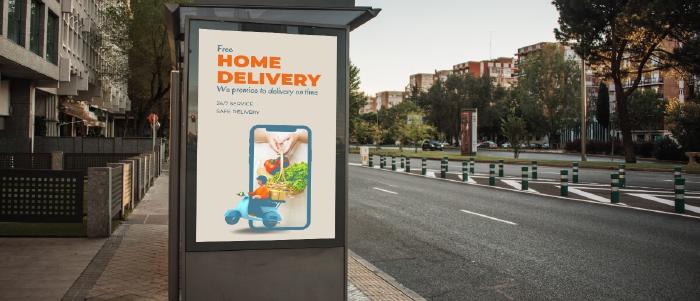
Jan 4 2023
11 min read

If you ever took a moment to look around a busy street while in traffic, you wouldn’t have missed the attractive digital billboards. Best known for their vibrant and dynamic displays, digital billboards are the new face of outdoor advertising. In 2025, advancements in digital signage software and digital signage solutions are making this technology more edgier.
Studies depict that the global digital billboard market for out-of-home-advertising will hit US $19.08 billion in 2025, driven by AI, sustainability, and immersive tech.
What’s new in digital billboards? There’s interactive advertising billboards, billboards with touchless capabilities and 3D technology enabled digital billboards which are taking outdoor marketing by a storm across the globe.
In this blog, we’ll break down what digital billboards are, their types, costs, and how to implement them.
A digital billboard is a large electronic display screen that is used for out-of-home advertising purposes. Unlike traditional billboards, digital billboards screens -
Update content remotely via digital signage software
Show motion graphics, real-time data (weather, traffic), or interactive content
Use energy-efficient tech, cutting power use by 40% vs. older models (DOE)
These high-impact displays are primarily used in high-traffic hubs such as New York’s Times Square, Tokyo’s Shibuya Crossing, London’s Piccadilly Circus or Bangalore’s Brigade Road to engage a broader audience with creative and timely messages.
Digital billboards come in various forms, each suited to different locations and purposes:

LED billboards: These are the most common type of digital billboards. LED billboards have their best features as high brightness and durability, making them ideal for outdoor use.
LCD billboards: LCD billboards, on the other hand, are more suitable for indoor or sheltered outdoor locations, providing excellent image quality.
Interactive billboards incorporate motion sensors, face detection, and voice or QR code activation. Digital interactive and informational kiosks powered by Pickcel digital signage software can engage more visitors by offering dynamic content, games, and quizzes.
Learn more about Pickcel’s interactive digital signage solution
Mobile digital billboards are trucks mounted with digital signage screens on multiple sides that target crowds in real-time. They deliver programmatic, location-based advertising and are ideal for reaching audiences in busy urban areas. Popular at festivals or protests.

These are the sides of buildings that are wrapped or curved and use see-through digital screens for futuristic visuals.
3D or Naked Eye Digital Billboards uses 3D technology to create holograms or parallax that bring depth and out of screen effects to videos and animations.
Before you set up a digital billboard for your outdoor marketing strategy, it’s essential to ask yourself some key questions. Understanding your audience, defining your objectives, and evaluating costs are crucial steps for a successful campaign.
Begin with these important components:
Location selection is a top priority in setting up a successful digital billboard. Go for a high-traffic location which ensures maximum attractions and visibility for visitors and onlookers.
For best location and site selection, consider these key factors-
Locations with a younger, tech-savvy crowd may benefit more from interactive or 3D digital billboards, while corporate hubs might prioritize content that communicates business messaging.
Your chosen site should provide optimal conditions for the billboard’s operation, ensuring the screen is protected from harsh weather and vandalism while maintaining clear visibility.
Ensure the location has access to reliable power sources and robust internet connectivity for seamless content updates via digital signage software.
Outdoor display screens range in size from 6×12 feet to 14×48 feet and are created to endure harsh weather while ensuring high resolution. Go for the ones that provide 2,000+ nits brightness.
A compact media player (similar to a set-top box) is connected to the display screen to download and cache content (images, videos, animations) for seamless performance. To showcase real-time content, go for 5-G enable screens.
Cloud-based platforms like Pickcel’s DOOH Solutions let you:
Digital signage software acts as the brain of the billboard, allowing remote management and real-time updates. Cloud‑based digital signage solutions provide flexibility and ease of use, enabling advertisers to instantly switch content across multiple locations.
Dynamic content is the demand of new age media intake. Digital billboards can display a mix of videos, scrolling text, animations, real time data, such as stocks, traffic or weather updates. This flexibility enhances the effectiveness of your digital billboard advertising.
To get the most out of our content, use bold fonts (visible from 500+ feet) and change your ads every 8–10 seconds.
| Digital Billboard Cost in 2025 | |
|---|---|
| Component | Cost in $ |
| LED or LCD Screen (48 ft) | 150,000–500,000 |
| Monthly Software | 200–1,000 |
| Permits (USA) | 10,000–50,000/year |
Digital billboard costs depend on various factors such as technology type, screen size, location, and installation complexity.
3D Digital billboards: These high tech billboards cost approximately $1,500 to $18,000 per month.
Standard LED or LCD billboards: These flat screen billboards typically range from $800 to $12,000 per month.
Leasing options: Rent space in hotspots like Times Square from $15,000 up to $15,000–$50,000 per month.
Additional factors include energy efficiency, maintenance, and regulatory compliance. An efficient digital signage software and digital signage solutions help optimize these costs by enabling remote management and reducing manual updates.
Digital billboards offer several compelling advantages for businesses:
Broader reach: Digital billboards in high-traffic hubs like Gangnam Station (Seoul) and Potsdamer Platz (Berlin), catch the eye of thousands of tourists and visitors, ensuring your dynamic content reaches a broader audience.
Dynamic engagement: Digital billboards’ dynamic 3D eye-catching visuals and real-time content captivates viewers more effectively than static advertisements.
Immediate updates: Most digital billboard screens easily update messages in real time for promotions, emergencies, or event-driven content.
Scalable campaigns: Digital billboards help to launch large-scale campaigns simultaneously across multiple locations, ensuring broad reach.
Cost-efficiency: Although setup costs may be high, digital billboards bring long-term savings from reduced printing, installation, and manual labor costs.
Sustainability: These outdoor advertising screens use energy-efficient LED technology that reduces power consumption and environmental impact.
Interactivity: Digital billboard features such as QR codes and touchless interfaces provide measurable engagement and actionable insights.
| Some Common Billboard Regulations Across The World | |
|---|---|
| U.S.A. | Brightness capped at 0.3 ft-L (night), 10,000 nits (day) |
| EU | Requires energy-efficient displays (Energy Star certified) |
| Japan | Earthquake-proof mounts in seismic zones. |
As much as digital billboards attract visitors, they also distract drivers and pose possible danger for pedestrians. Thus, strict safety and environmental regulations have been adopted in various regions, especially in the USA to ensure that these outdoor advertising displays are both safe and sustainable.
Regulations focus on:
Digital billboards have changed the game for outdoor advertising beyond static texts and visuals. The transition from traditional to 2025 digital billboard advertising has been driven by cost‑efficiency, real‑time content management, and enhanced interactivity.
Now is the time to leverage the power of digital billboards to elevate your brand’s visibility and impact your audience like never before.
With Pickcel’s digital signage solutions, launching campaigns is faster, smarter, and sustainable.

Digital billboards offer dynamic content, real‑time updates, and enhanced targeting capabilities. They reduce recurring printing and installation costs, provide measurable engagement data, and deliver a more immersive advertising experience.
Digital billboard advertising leverages dynamic content that can be updated in real time, enabling targeted, programmatic campaigns across multiple locations.
Content can be updated instantly or on a scheduled basis using cloud‑based digital signage software, allowing advertisers to react quickly to market changes, events, or emergency alerts.
Yes, digital billboards can work with mobile campaigns through interactive features like QR codes and geotargeting, enabling a seamless bridge between outdoor advertising and mobile engagement.

Jan 4 2023
11 min read

Oct 18 2022
13 min read
![What are 3D digital billboards for advertising? [5 Examples]](/blog/images/3d-advertising-billboard/banner_hu3a52995533a2f5f6af3321531a883f0d_86539_700x0_resize_q75_box.jpg)
Sep 8 2022
6 min read

Jul 15 2022
11 min read
Take complete control of what you show on your digital signage & how you show it.
Start Free Trial Schedule My Demo

Managing 100s of Screens Outside Glitch-Free — Discover How Ideawale Executed Countrywide Ads and Saw 210% Increase in Sales
Unlock Exclusive Insights